Cement Equivalence of Metakaolin for Workability, Cohesiveness, Strength and Sorptivity of Concrete
Abstract
1. Introduction
2. Materials and Research Design
2.1. Materials
2.2. Concrete Mixes
3. Testing Methods
3.1. Slump and Flow Measurement
3.2. Segregation Index Measurement
3.3. Compressive Strength Measurement
3.4. Sorptivity Coefficient Measurement
4. Testing Results
4.1. Fresh Properties
4.2. Strength
4.3. Sorptivity
5. Evaluation of CEFs
5.1. Extension of CEF to Fresh Properties
5.2. Workability and Cohesiveness
5.3. Strength
5.4. Sorptivity
6. Concurrently Achieved Performances
6.1. Concurrently Achieved Cohesiveness and Flowability
6.2. Concurrently Achieved Strength and Flowability
6.3. Concurrently Achieved Durability and Flowability
6.4. Overall Remarks on the CEFs of MK
7. Conclusions
- (1)
- The addition of up to 20% MK as OPC replacement best improved the 28-day and 70-day cube strengths; whereas, the addition of up to 30% MK as OPC replacement always improved the cohesiveness (in terms of segregation index) and durability (in terms of sorptivity), but impaired the workability (in terms of slump and flow).
- (2)
- Regarding the fresh properties, the ranges of CEFs of MK were 1.44 to 2.71, 1.65 to 2.70, and 2.77 to 4.58 for slump, flow, and cohesiveness, respectively. The corresponding average CEFs were 1.98, 2.17, and 3.83, respectively. It is noteworthy that the CEF for cohesiveness was larger than those for workability.
- (3)
- Regarding the strength, the ranges of CEFs of MK were 1.17 to 1.93 and 1.26 to 2.12 for 28-day and 70-day cube strengths, respectively. The corresponding average CEFs were 1.93 and 2.12, respectively. As expected, the CEF for 70-day strength was slightly higher than that for 28-day strength.
- (4)
- Regarding the durability, the ranges of CEFs of MK was 3.80 to 5.58 for the sorptivity coefficient, and the corresponding average CEF was as high as 4.70, which indicated that the MK is highly effective in reducing the sorptivity.
- (5)
- For all the performance attributes including workability, cohesiveness, strength and durability, all the CEFs of MK were larger than unity and generally increased with increasing W/CM ratio and decreased with increasing MK content.
- (6)
- The concurrently achieved performances showed that the MK was a highly effective cementitious material for improving the cohesiveness, strength, and durability, albeit it could reduce the workability.
Author Contributions
Funding
Acknowledgments
Conflicts of Interest
Appendix A
| Mix no. (M-VMK- W/CM) | Slump (mm) | Flow (mm) | SI (%) | 28-Day Strength (MPa) | 70-Day Strength (MPa) | Sorptivity Coefficient (mm/s0.5) |
|---|---|---|---|---|---|---|
| M-0-0.25 | 112.5 | 63.1 | 17.8 | 54.2 | 64.7 | 0.015 |
| M-0-0.30 | 159.0 | 95.7 | 22.5 | 45.8 | 54.6 | 0.016 |
| M-10-0.30 | 139.5 | 78.3 | 19.4 | 49.4 | 59.1 | 0.013 |
| M-20-0.30 | 137.0 | 66.7 | 18.0 | 52.2 | 62.6 | 0.010 |
| M-30-0.30 | 133.0 | 62.4 | 17.6 | 48.9 | 58.8 | 0.009 |
| M-0-0.35 | 153.0 | 101.4 | 25.7 | 46.9 | 53.2 | 0.028 |
| M-0-0.40 | 186.5 | 136.1 | 26.3 | 32.1 | 38.0 | 0.029 |
| M-10-0.40 | 164.0 | 124.0 | 22.6 | 38.7 | 46.2 | 0.018 |
| M-20-0.40 | 159.5 | 114.4 | 20.9 | 40.8 | 48.5 | 0.014 |
| M-30-0.40 | 154.0 | 106.7 | 19.9 | 37.0 | 45.3 | 0.013 |
| M-0-0.45 | 181.5 | 201.3 | 25.1 | 28.2 | 29.8 | 0.031 |
| M-0-0.50 | 190.0 | 190.3 | 27.4 | 27.9 | 33.7 | 0.034 |
| M-10-0.50 | 179.5 | 167.8 | 24.6 | 33.0 | 39.5 | 0.024 |
| M-20-0.50 | 175.5 | 147.6 | 22.5 | 34.0 | 41.0 | 0.019 |
| M-30-0.50 | 170.5 | 142.3 | 21.3 | 30.7 | 37.1 | 0.017 |
| M-0-0.55 | 196.0 | 181.2 | 27.6 | 26.1 | 31.5 | 0.040 |
| M-0-0.60 | 207.5 | 234.2 | 29.5 | 22.8 | 28.4 | 0.055 |
| M-10-0.60 | 197.0 | 197.3 | 26.7 | 27.7 | 33.3 | 0.031 |
| M-20-0.60 | 191.5 | 178.7 | 24.2 | 28.9 | 35.0 | 0.023 |
| M-30-0.60 | 185.5 | 171.8 | 23.5 | 26.2 | 32.9 | 0.019 |
| MK Content (%) | W/CM Ratio | CEF | |||||
|---|---|---|---|---|---|---|---|
| Slump | Flow | SI | 28-Day Strength | 70-Day Strength | Sorptivity | ||
| 10 | 0.30 | 1.57 | 1.89 | 3.81 | 1.64 | 1.87 | 4.88 |
| 0.40 | 1.93 | 2.48 | 3.88 | 2.17 | 2.40 | 5.21 | |
| 0.50 | 2.71 | 2.36 | 4.50 | 3.03 | 3.27 | 5.58 | |
| 0.60 | 2.67 | 2.70 | 4.33 | 3.10 | 3.42 | 5.55 | |
| 20 | 0.30 | 1.44 | 1.83 | 3.37 | 1.66 | 1.80 | 4.40 |
| 0.40 | 1.76 | 2.07 | 3.61 | 1.92 | 2.01 | 4.60 | |
| 0.50 | 2.13 | 2.40 | 4.33 | 2.19 | 2.39 | 4.90 | |
| 0.60 | 2.22 | 2.52 | 4.58 | 2.34 | 2.54 | 5.05 | |
| 30 | 0.30 | 1.47 | 1.65 | 2.77 | 1.17 | 1.26 | 3.80 |
| 0.40 | 1.76 | 1.89 | 3.24 | 1.20 | 1.36 | 3.82 | |
| 0.50 | 1.98 | 2.05 | 3.83 | 1.34 | 1.45 | 3.94 | |
| 0.60 | 2.10 | 2.18 | 3.75 | 1.43 | 1.72 | 4.62 | |
| Minimum | 1.44 | 1.65 | 2.77 | 1.17 | 1.26 | 3.80 | |
| Maximum | 2.71 | 2.70 | 4.58 | 3.10 | 3.42 | 5.58 | |
| Average | 1.98 | 2.17 | 3.83 | 1.93 | 2.12 | 4.70 | |
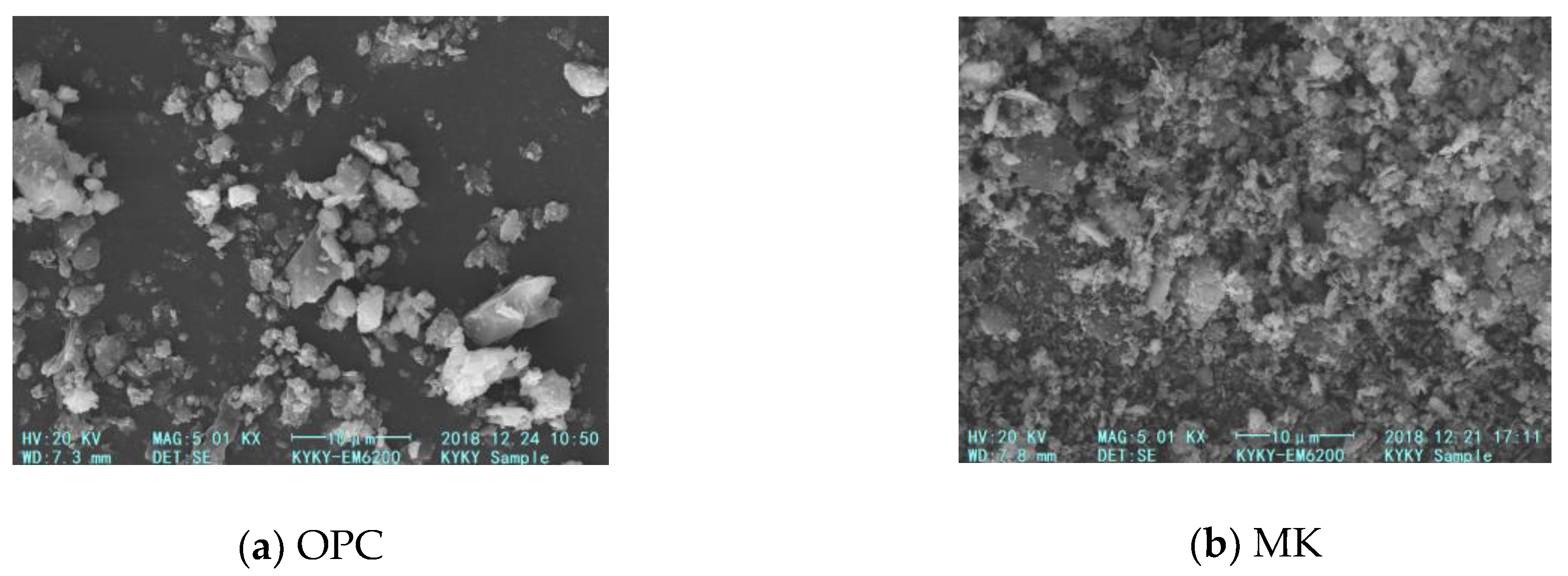
References
- Aїtcin, P.-C. Improving the sustainability of high performance concrete, Keynote paper. In Proceedings of the 9th International Symposium on High Performance Concrete, Rotorua, New Zealand, 9–11 August 2011. [Google Scholar]
- Cheng, S.; Shui, Z.; Sun, T.; Huang, Y.; Liu, K. Effects of seawater and supplementary cementitious materials on the durability and microstructure of lightweight aggregate concrete. Constr. Build. Mater. 2018, 190, 1081–1090. [Google Scholar] [CrossRef]
- Abouhussien, A.A.; Hassan, A.A.A. Monitoring early age strength gain of SCC with different supplementary cementitious materials using acoustic emission sensors. Constr. Build. Mater. 2019, 229, 116858. [Google Scholar] [CrossRef]
- Ashish, D.K. Concrete made with waste marble powder and supplementary cementitious material for sustainable development. J. Clean. Prod. 2019, 211, 716–729. [Google Scholar] [CrossRef]
- Kakali, G.; Perraki, T.; Tsivilis, S.; Badogiannis, E. Thermal treatment of kaolin: The effect of mineralogy on the pozzolanic activity. Appl. Clay Sci. 2001, 20, 73–80. [Google Scholar] [CrossRef]
- Sabir, B.B.; Wild, S.; Bai, J. Metakaolin and calcined clays as pozzolans for concrete: A review. Cem. Concr. Compos. 2001, 23, 441–454. [Google Scholar] [CrossRef]
- Kostuch, J.A.; Walters, G.V.; Jones, T.R. High Performance Concrete Incorporating Metakaolin: A Review; Dhir, R.K., Roderick Jones, M., Eds.; Concrete 2000; E&FN Spon: London, UK, 1993; pp. 1799–1811. [Google Scholar]
- Fernandez, R.; Martirena, F.; Scrivener, K.L. The origin of the pozzolanic activity of calcined clay minerals: A comparison between kaolinite, illite and montmorillonite. Cem. Concr. Res. 2011, 41, 113–122. [Google Scholar] [CrossRef]
- Barbhuiya, S.; Chow, P.; Memon, S. Microstructure, hydration and nanomechanical properties of concrete containing metakaolin. Constr. Build. Mater. 2015, 95, 696–702. [Google Scholar] [CrossRef]
- Shen, P.; Lu, L.; Chen, W.; Wang, F.; Hu, S. Efficiency of metakaolin in steam cured high strength concrete. Constr. Build. Mater. 2017, 152, 357–366. [Google Scholar] [CrossRef]
- Chu, S.H.; Kwan, A.K.H. Co-addition of metakaolin and silica fume in mortar: Effects and advantages. Constr. Build. Mater. 2018, 197, 716–724. [Google Scholar] [CrossRef]
- Hassan, A.A.A.; Lachemi, M.; Hossain, K.M.A. Effect of metakaolin and silica fume on the durability of self-consolidating concrete. Cem. Concr. Compos. 2012, 34, 801–807. [Google Scholar] [CrossRef]
- Nazário Santos, F.; de Sousa, S.R.G.; José Faria Bombard, A.; Vieira, S.L. Rheological study of cement paste with metakaolin and/or limestone filler using mixture design of experiments. Constr. Build. Mater. 2017, 143, 92–103. [Google Scholar] [CrossRef]
- Muduli, R.; Mukharjee, B.B. Effect of incorporation of metakaolin and recycled coarse aggregate on properties of concrete. J. Clean. Prod. 2019, 209, 398–414. [Google Scholar] [CrossRef]
- Nguyen Amanjean, E.; Mouret, M.; Vidal, T. Effect of design parameters on the properties of ultra-high performance fibre-reinforced concrete in the fresh state. Constr. Build. Mater. 2019, 224, 1007–1017. [Google Scholar] [CrossRef]
- Justice, J.M.; Kurtis, K.E. Influence of metakaolin surface area on properties of cement-based materials. J. Mater. Civ. Eng. ASCE 2007, 19, 762–771. [Google Scholar] [CrossRef]
- Cassagnabère, F.; Mouret, M.; Escadeillas, G.; Broilliard, P.; Bertrand, A. Metakaolin, a solution for the precast industry to limit the clinker content in concrete: Mechanical aspects. Constr. Build. Mater. 2010, 24, 1109–1118. [Google Scholar] [CrossRef]
- Güneyisi, E.; Gesoğlu, M.; Karaoğlu, S.; Mermerdaş, K. Strength, permeability and shrinkage cracking of silica fume and metakaolin concretes. Constr. Build. Mater. 2012, 34, 120–130. [Google Scholar] [CrossRef]
- Valipour, M.; Pargar, F.; Shekarchi, M.; Khani, S. Comparing a natural pozzolan, zeolite, to metakaolin and silica fume in terms of their effect on the durability characteristics of concrete: A laboratory study. Constr. Build. Mater. 2013, 41, 879–888. [Google Scholar] [CrossRef]
- Valipour, M.; Pargar, F.; Shekarchi, M.; Khani, S.; Moradian, M. In situ study of chloride ingress in concretes containing natural zeolite, metakaolin and silica fume exposed to various exposure conditions in a harsh marine environment. Constr. Build. Mater. 2013, 46, 63–70. [Google Scholar] [CrossRef]
- Kiachehr, B.; Omid, F. The effects of pozzolanic binders and polypropylene fibers on durability of SCC to magnesium sulphate attack. Constr. Build. Mater. 2013, 38, 64–71. [Google Scholar]
- Kavitha, O.R.; Shanthi, V.M.; Prince Arulraj, P.; Sivakumar, V.R. Microstructural studies on eco-friendly and durable self-compacting concrete blended with metakaolin. Appl. Clay Sci. 2016, 124–125, 143–149. [Google Scholar] [CrossRef]
- Tafraoui, A.; Escadeillas, G.; Vidal, T. Durability of the ultra high performances concrete containing metakaolin. Constr. Build. Mater. 2016, 112, 980–987. [Google Scholar] [CrossRef]
- Saboo, N.; Shivhare, S.; Kori, K.K.; Chandrappa, A.K. Effect of fly ash and metakaolin on pervious concrete properties. Constr. Build. Mater. 2019, 223, 322–328. [Google Scholar] [CrossRef]
- Tafraoui, A.; Escadeillas, G.; Lebaili, S.; Vidal, T. Metakaolin in the formulation of UHPC. Constr. Build. Mater. 2009, 23, 669–674. [Google Scholar] [CrossRef]
- Chen, L.; Zheng, K.; Xia, T.; Long, G. Mechanical property, sorptivity and microstructure of steam-cured concrete incorporated with the combination of metakaolin-limestone. Case Studs. Constr. Mater. 2019, 11, 1–11. [Google Scholar] [CrossRef]
- Papadakis, V.G.; Antiohos, S.; Tsimas, S. Supplementary cementing materials in concrete: Part II: A fundamental estimation of the efficiency factor. Cem. Concr. Res. 2002, 32, 1533–1538. [Google Scholar] [CrossRef]
- Yildirim, H.; Sümer, M.; Akyüncü, V.; Gürbüz, E. Comparison on efficiency factors of F and C types of fly ashes. Constr. Build. Mater. 2011, 25, 2939–2947. [Google Scholar] [CrossRef]
- Al-Rezaiqi, J.; Alnuaimi, A.; Hago, A.W. Efficiency factors of burnt clay and cement kiln dust and their effects on properties of blended concrete. Appl. Clay Sci. 2018, 157, 51–64. [Google Scholar] [CrossRef]
- Papadakis, V.G.; Tsimas, S. Supplementary cementing materials in concrete: Part I: Efficiency and design. Cem. Concr. Res. 2002, 32, 1525–1532. [Google Scholar] [CrossRef]
- Wong, H.S.; Razak, H.A. Efficiency of calcined kaolin and silica fume as cement replacement material for strength performance. Cem. Concr. Res. 2005, 35, 696–702. [Google Scholar] [CrossRef]
- Aponte, D.F.; Barra, M.; Vàzquez, E. Durability and cementing efficiency of fly ash in concretes. Constr. Build. Mater. 2012, 30, 537–546. [Google Scholar] [CrossRef]
- Latha, K.S.; Rao, M.V.S.; Srinivasa, R.V. Estimation of GGBS and HVFA strength efficiencies in concrete with age. Int. J. Eng. Adv. Technol. 2012, 2, 221–225. [Google Scholar]
- Gruyaert, E.; Maes, M.; De Belie, N. Performance of BFS concrete: K-value concept versus equivalent performance concept. Constr. Build. Mater. 2013, 47, 441–455. [Google Scholar] [CrossRef]
- Antiohos, S.K.; Papadakis, V.G.; Tsimas, S. Rice husk ash (RHA) effectiveness in cement and concrete as a function of reactive silica and fineness. Cem. Concr. Res. 2014, 61–62, 20–27. [Google Scholar] [CrossRef]
- Lollini, F.; Redaelli, E.; Bertolini, L. A study on the applicability of the efficiency factor of supplementary cementitious materials to durability properties. Constr. Build. Mater. 2016, 120, 284–292. [Google Scholar] [CrossRef]
- Li, L.G.; Zheng, J.Y.; Zhu, J.; Kwan, A.K.H. Combined usage of micro-silica and nano-silica in concrete: SP demand, cementing efficiencies and synergistic effect. Constr. Build. Mater. 2018, 168, 622–632. [Google Scholar] [CrossRef]
- Li, L.G.; Zheng, J.Y.; Ng, P.L.; Zhu, J.; Kwan, A.K.H. Cementing efficiencies and synergistic roles of silica fume and nano-silica in sulphate and chloride resistance of concrete. Constr. Build. Mater. 2019, 223, 965–975. [Google Scholar] [CrossRef]
- Wild, S.; Khatib, J.M.; Jones, A. Relative strength, pozzolanic activity and cement hydration in superplasticised metakaolin concrete. Cem. Concr. Res. 1996, 26, 1537–1544. [Google Scholar] [CrossRef]
- Ding, J.T.; Li, Z. Effects of metakaolin and silica fume on properties of concrete. ACI Mater. J. 2002, 99, 393–398. [Google Scholar]
- Abdul Razak, H.; Wong, H.S. Strength estimation model for high-strength concrete incorporating metakaolin and silica fume. Cem. Concr. Res. 2005, 35, 688–695. [Google Scholar] [CrossRef]
- Poon, C.S.; Kou, S.C.; Lam, L. Compressive strength, chloride diffusivity and pore structure of high performance metakaolin and silica fume concrete. Constr. Build. Mater. 2006, 20, 858–865. [Google Scholar] [CrossRef]
- Ramezanianpour, A.A.; Bahrami Jovein, H. Influence of metakaolin as supplementary cementing material on strength and durability of concretes. Constr. Build. Mater. 2012, 30, 470–479. [Google Scholar] [CrossRef]
- Mardani-Aghabaglou, A.; Sezer, G.İ.; Ramyar, K. Comparison of fly ash, silica fume and metakaolin from mechanical properties and durability performance of mortar mixtures view point. Constr. Build. Mater. 2014, 70, 17–25. [Google Scholar] [CrossRef]
- Akcay, B.; Tasdemir, M.A. Performance evaluation of silica fume and metakaolin with identical finenesses in self compacting and fiber reinforced concretes. Constr. Build. Mater. 2018, 185, 436–444. [Google Scholar] [CrossRef]
- European Committee for Standardization (CEN). EN 197-1: Cement. Part 1: Composition, Specifications and Conformity Criteria for Common Cements; European Committee for Standardization (CEN): Brussels, Belgium, 2011. [Google Scholar]
- General Administration of Quality Supervision, Inspection and Quarantine of the People’s Republic of China. GB/T 18736: Mineral Admixtures for High Strength and High Performance Concrete; Standardization Administration of the People’s Republic of China: Beijing, China, 2017; (In Chinese).
- Yunnan Provincial Bureau of Quality and Technical Supervision. DB 53/T 843: Metakaolin for Use in Concrete; Yunnan Provincial Bureau of Quality and Technical Supervision: Kunming, China, 2017; (In Chinese).
- British Standards Institution. BS 882: Specification for Aggregates from Natural Sources for Concrete; British Standards Institution: London, UK, 1992. [Google Scholar]
- British Standards Institution. BS 812-2: Testing Aggregates—Methods for Determination of Density; British Standards Institution: London, UK, 1995. [Google Scholar]
- Bernal, J.; Reyes, E.; Massana, J.; León, N.; Sánchez, E. Fresh and mechanical behavior of a self-compacting concrete with additions of nano-silica, silica fume and ternary mixtures. Constr. Build. Mater. 2018, 160, 196–210. [Google Scholar] [CrossRef]
- Chen, J.J.; Kwan, A.K.H.; Jiang, Y. Adding limestone fines as cement paste replacement to reduce water permeability and sorptivity of concrete. Constr. Build. Mater. 2014, 56, 87–93. [Google Scholar] [CrossRef]
- Chen, J.J.; Ng, P.L.; Kwan, A.K.H.; Li, L.G. Lowering cement content in mortar by adding superfine zeolite as cement replacement and optimizing mixture proportions. J. Clean. Prod. 2019, 210, 66–76. [Google Scholar] [CrossRef]
- Chu, S.H. Effect of paste volume on fresh and hardened properties of concrete. Constr. Build. Mater. 2019, 218, 284–294. [Google Scholar] [CrossRef]
- European Committee for Standardization (CEN). EN 12350-2: Testing Fresh Concrete. Part 2: Slump-Test; European Committee for Standardization (CEN): Brussels, Belgium, 2009. [Google Scholar]
- European Committee for Standardization (CEN). EN 12350-11: Testing Fresh Concrete. Part 11: Self-compacting Concrete—Sieve Segregation Test; European Committee for Standardization (CEN): Brussels, Belgium, 2010. [Google Scholar]
- European Committee for Standardization (CEN). EN 12390-2: Testing Hardened Concrete. Part 2: Making and Curing Specimens for Strength Tests; European Committee for Standardization (CEN): Brussels, Belgium, 2019. [Google Scholar]
- European Committee for Standardization (CEN). EN 12390-3: Testing Hardened Concrete. Part 3: Compressive Strength of Test Specimens; European Committee for Standardization (CEN): Brussels, Belgium, 2019. [Google Scholar]
- American Society for Testing and Materials. ASTM C1585-13: Standard Test Method for Measurement of Rate of Absorption of Water by Hydraulic-Cement Concretes; ASTM International: West Conshohocken, PA, USA, 2013. [Google Scholar]
- European Committee for Standardization (CEN). EN 206: Concrete—Specification, Performance, Production and Conformity; European Committee for Standardization (CEN): Brussels, Belgium, 2013. [Google Scholar]
- Comité Européen de Normalisation. PD CEN/TR 16639: Use of k-value Concept, Equivalent Concrete Performance Concept and Equivalent Performance of Combinations Concept; Comité Européen de Normalisation: Brussels, Belgium, 2014. [Google Scholar]
- Bureau de Normalisation. NBN B 15-100: Concrete—Methodology for the Assessment and the Validation of the Fitness for Use of Cements or Additions for Concrete; Bureau de Normalisation: Brussels, Belgium, 2008. [Google Scholar]
- Smith, I.A. The design of fly ash concrete. Proc. Inst. Civ. Eng. 1967, 36, 769–790. [Google Scholar] [CrossRef]
- Hobbs, D.W. Portland-pulverized fuel ash concretes: Water demand, 28 day strength, mix design and strength development. Proc. Inst. Civ. Eng. 1988, 85, 317–331. [Google Scholar] [CrossRef]
- Khayat, K.H. Optimization and performance of air-entrained, self-consolidating concrete. ACI Mater. J. 2000, 97, 526–535. [Google Scholar]
- Lotfy, A.; Hossain, K.M.A.; Lachemi, M. Mix design and properties of lightweight self-consolidating concretes developed with furnace slag, expanded clay and expanded shale aggregates. J. Sustain. Cem. Mater. 2016, 5, 297–332. [Google Scholar] [CrossRef]
- Ng, P.L.; Rudžionis, Ž.; Ng, I.Y.T.; Kwan, A.K.H. Development of sustainable high-strength self-consolidating concrete utilising fly ash, shale ash and microsilica. In Sustainable Building—Interaction between a Holistic Conceptual Act and Materials Properties; Almusaed, A., Almssad, A., Eds.; Intech: London, UK, 2018; pp. 113–130. [Google Scholar]
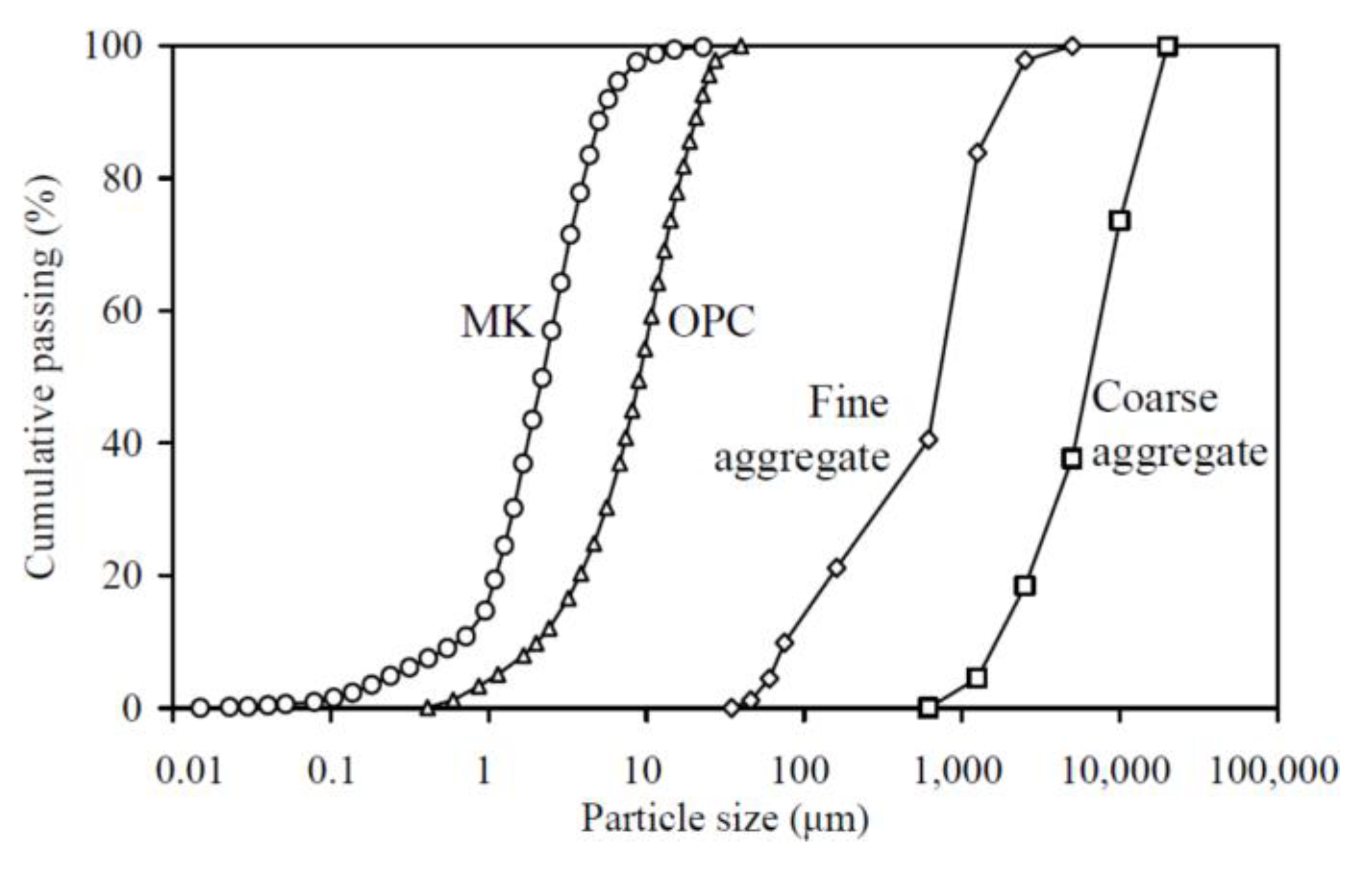
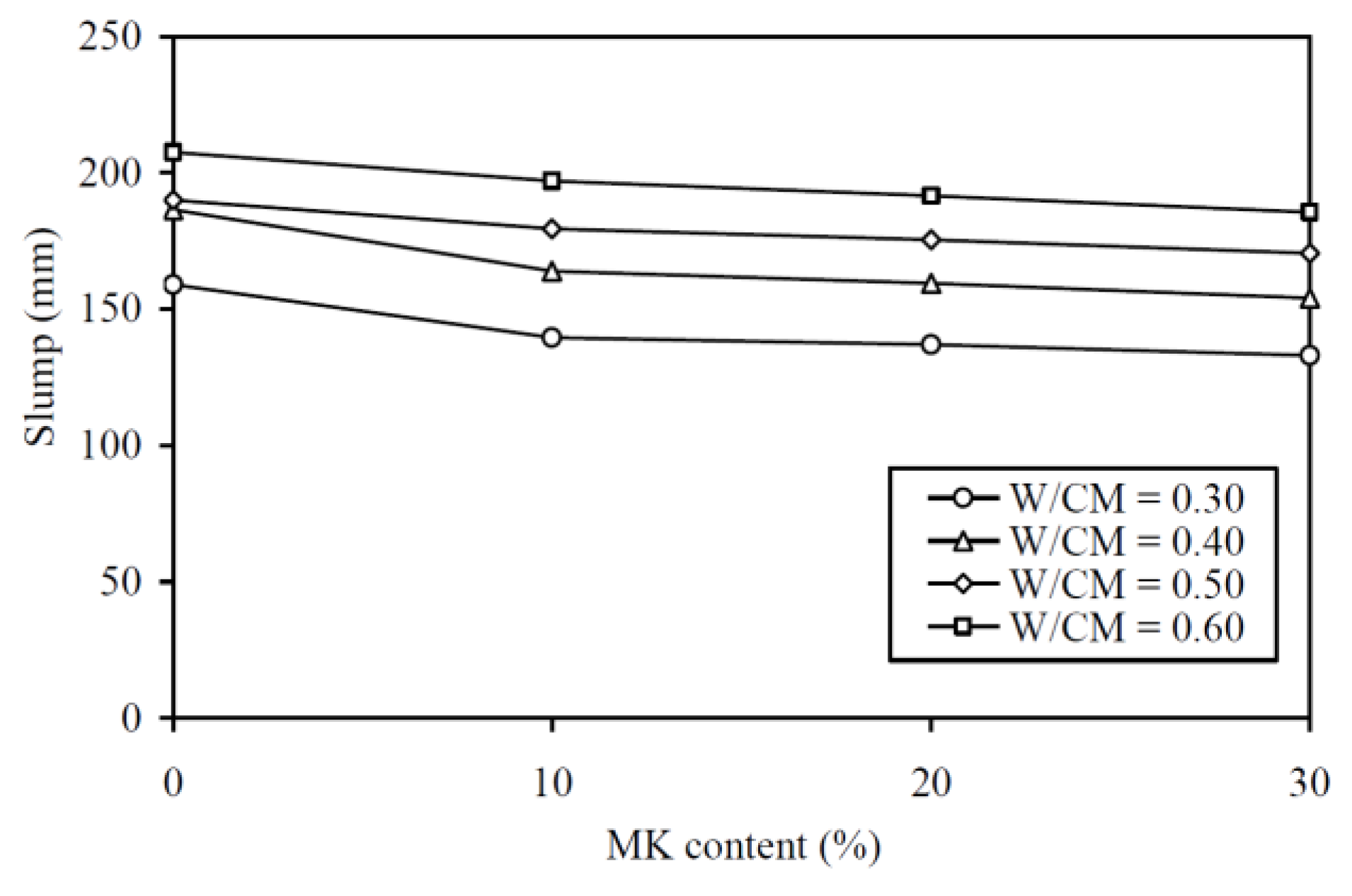
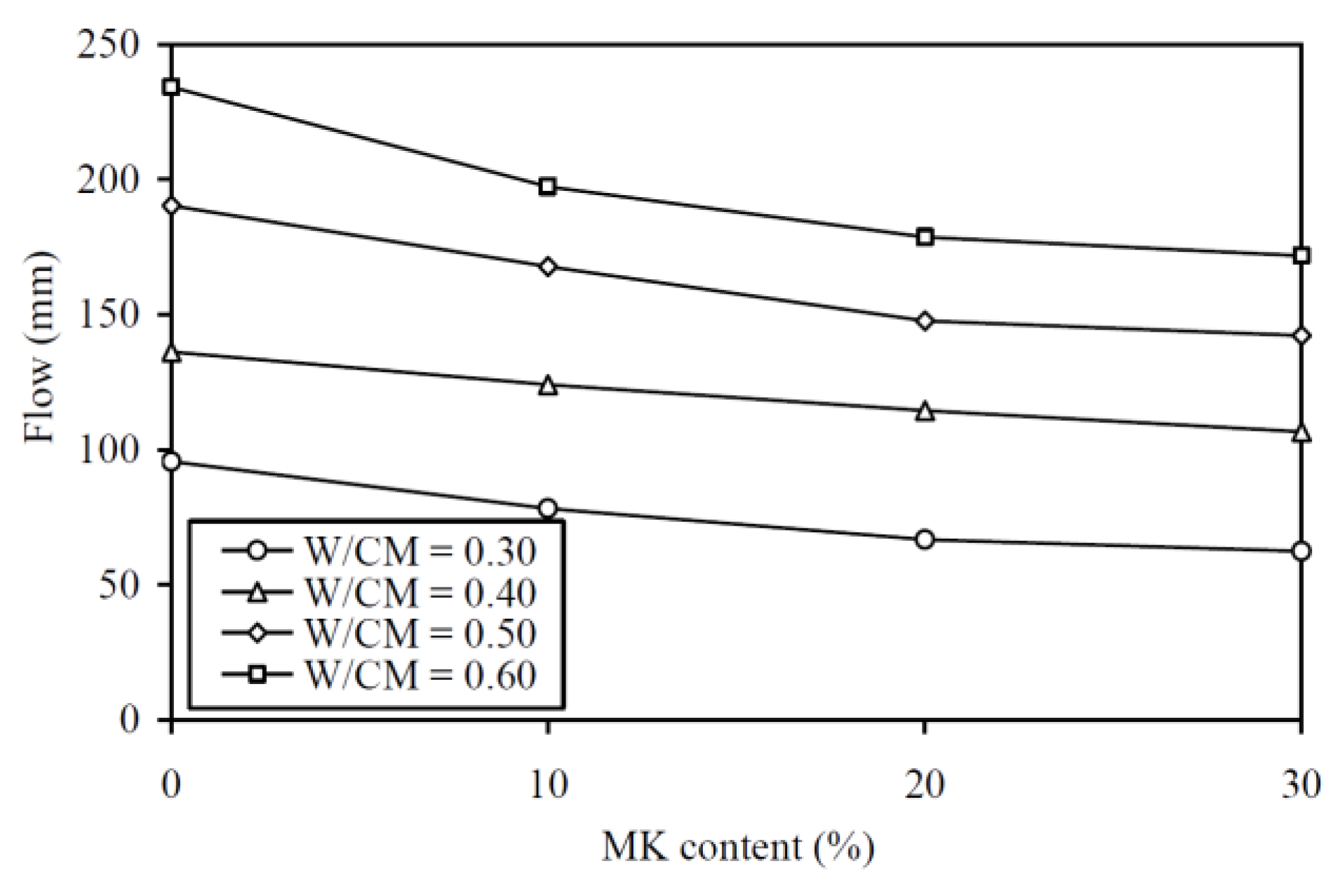
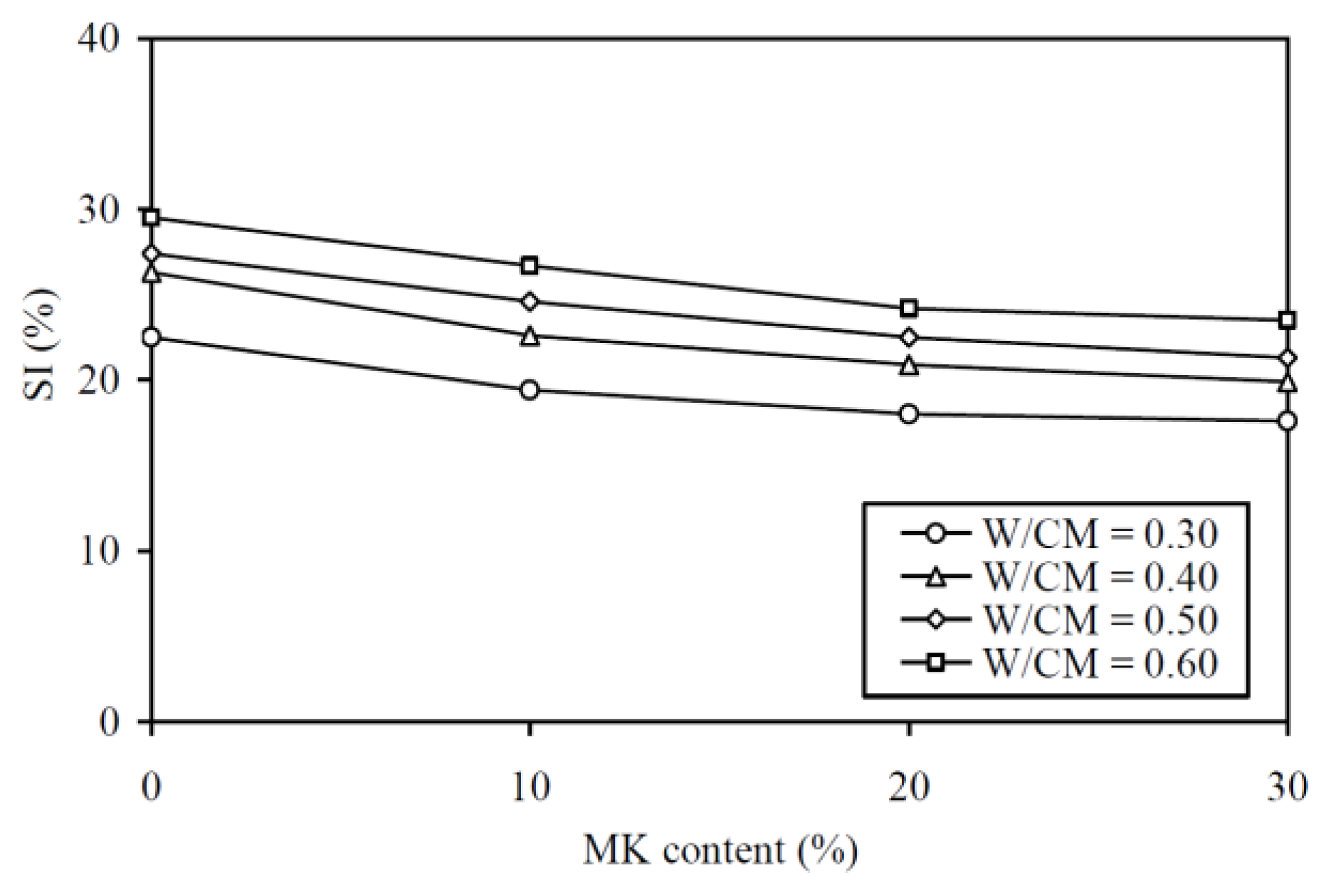


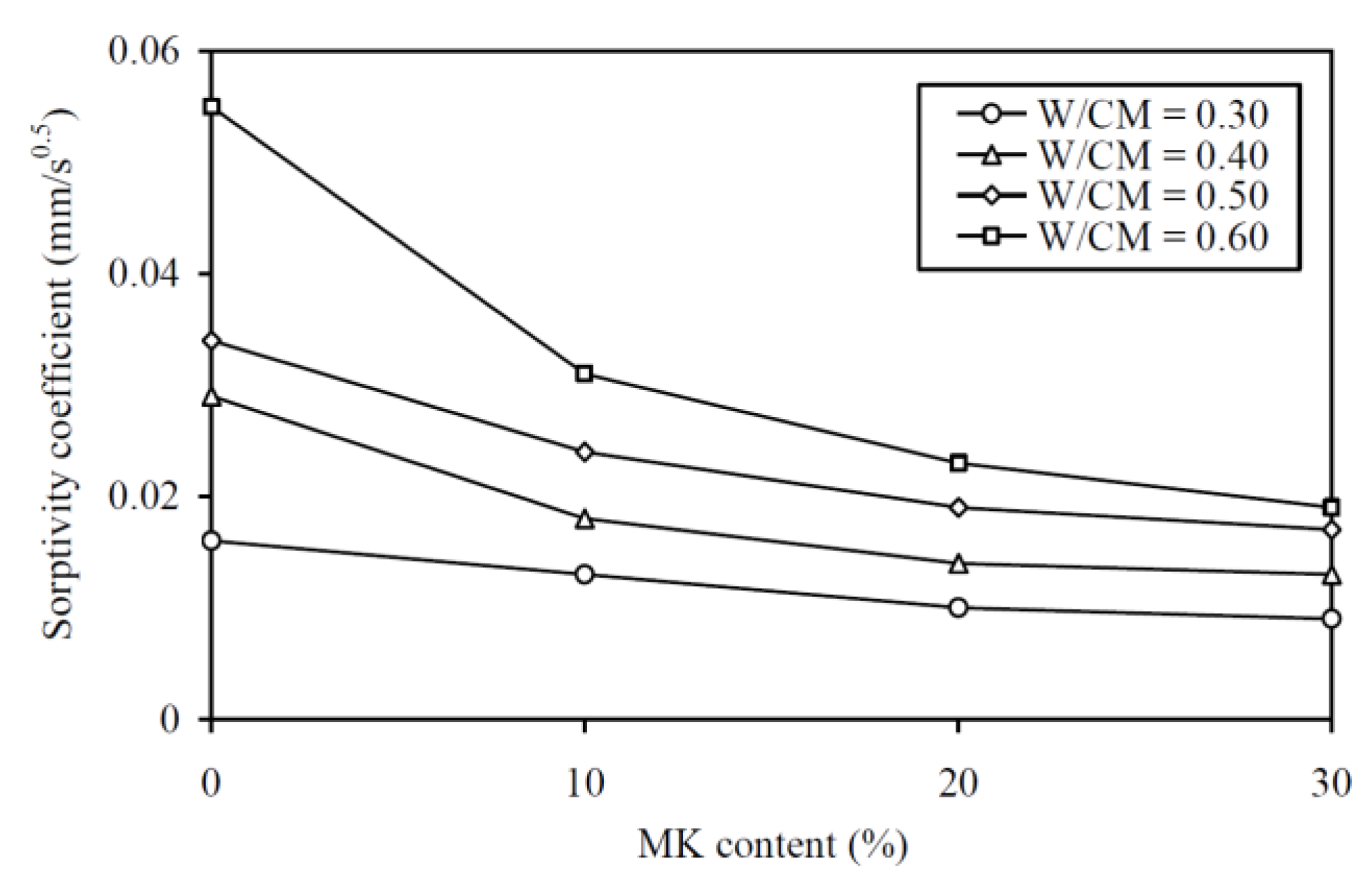
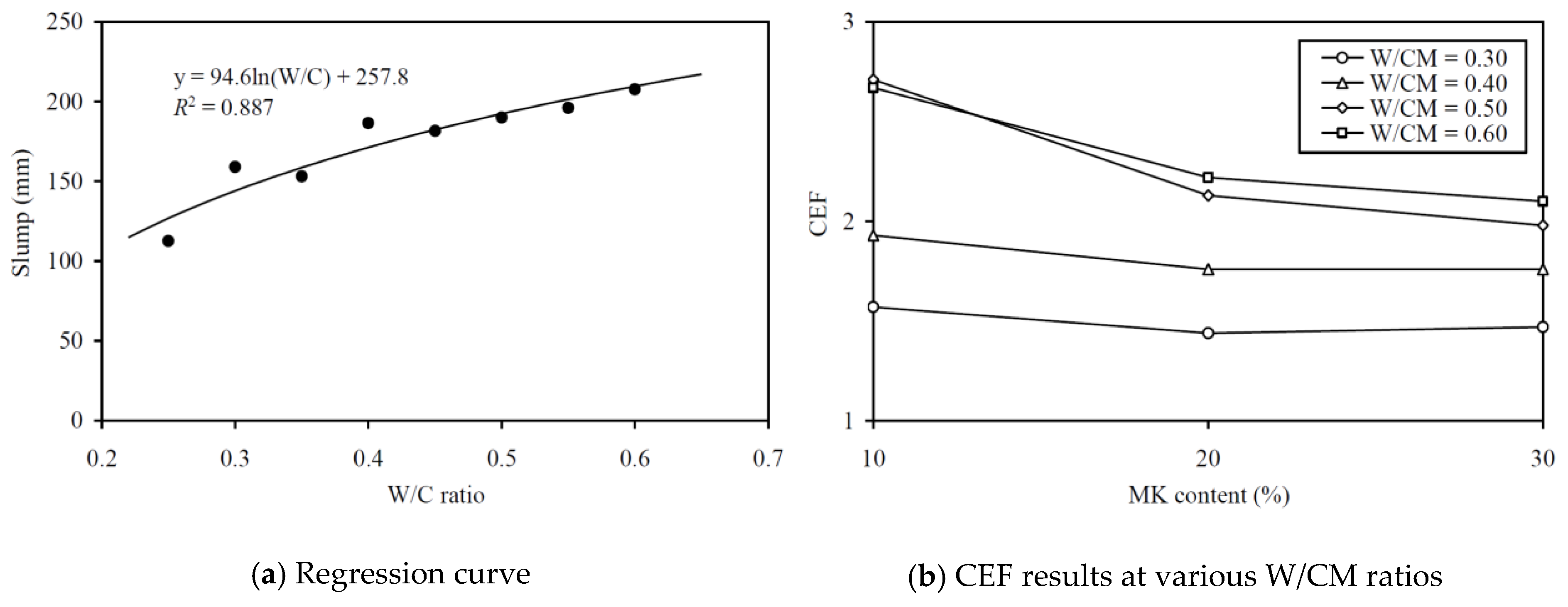
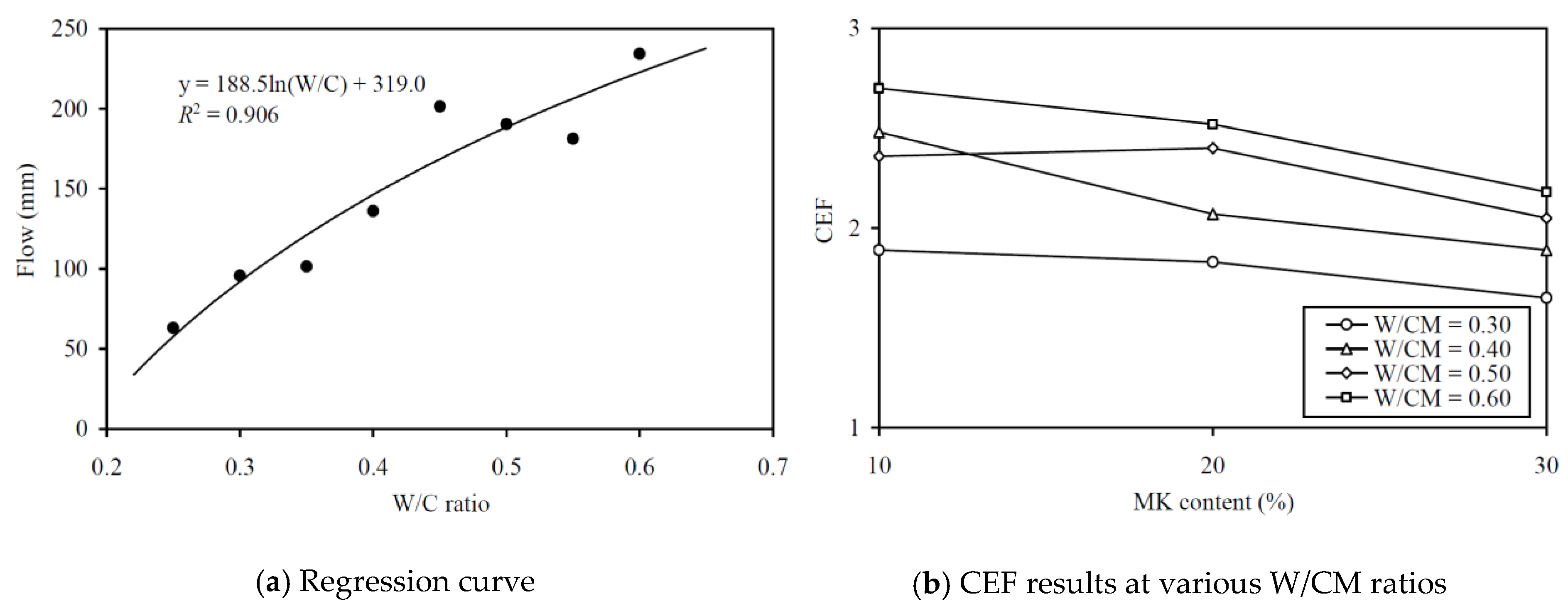


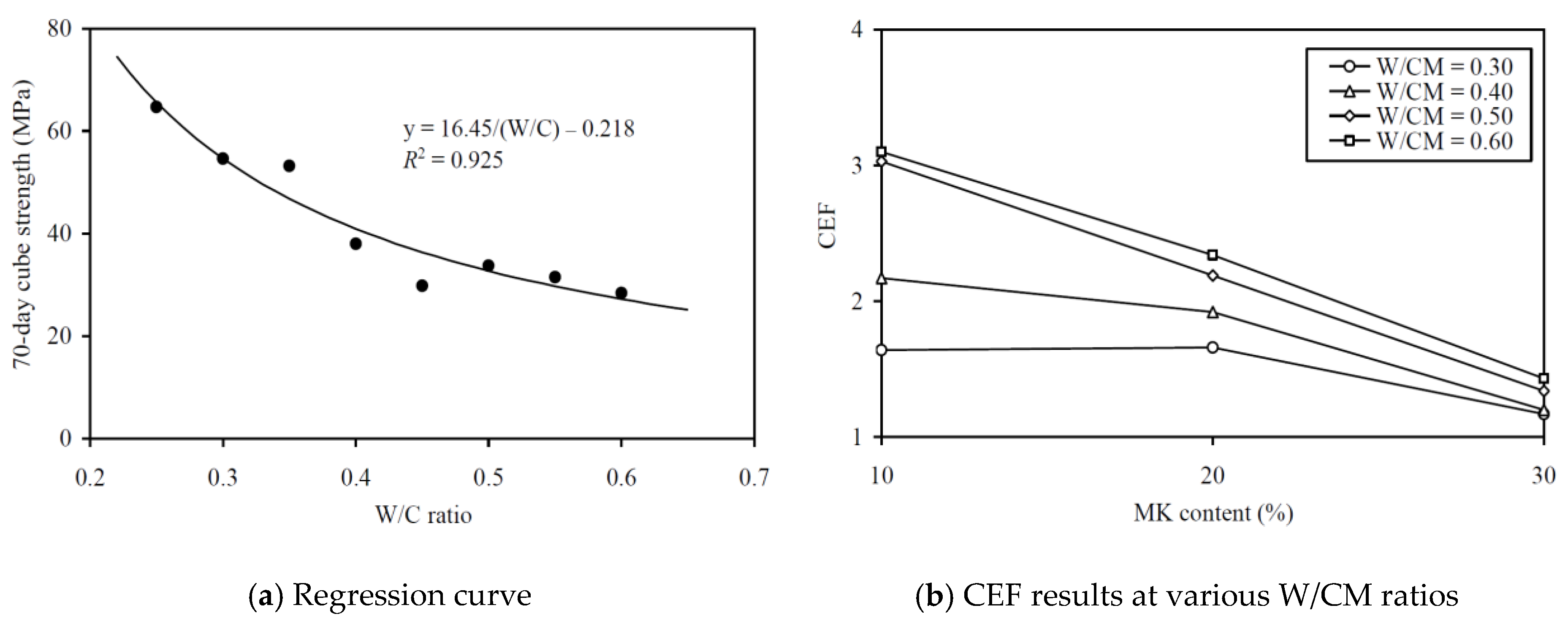
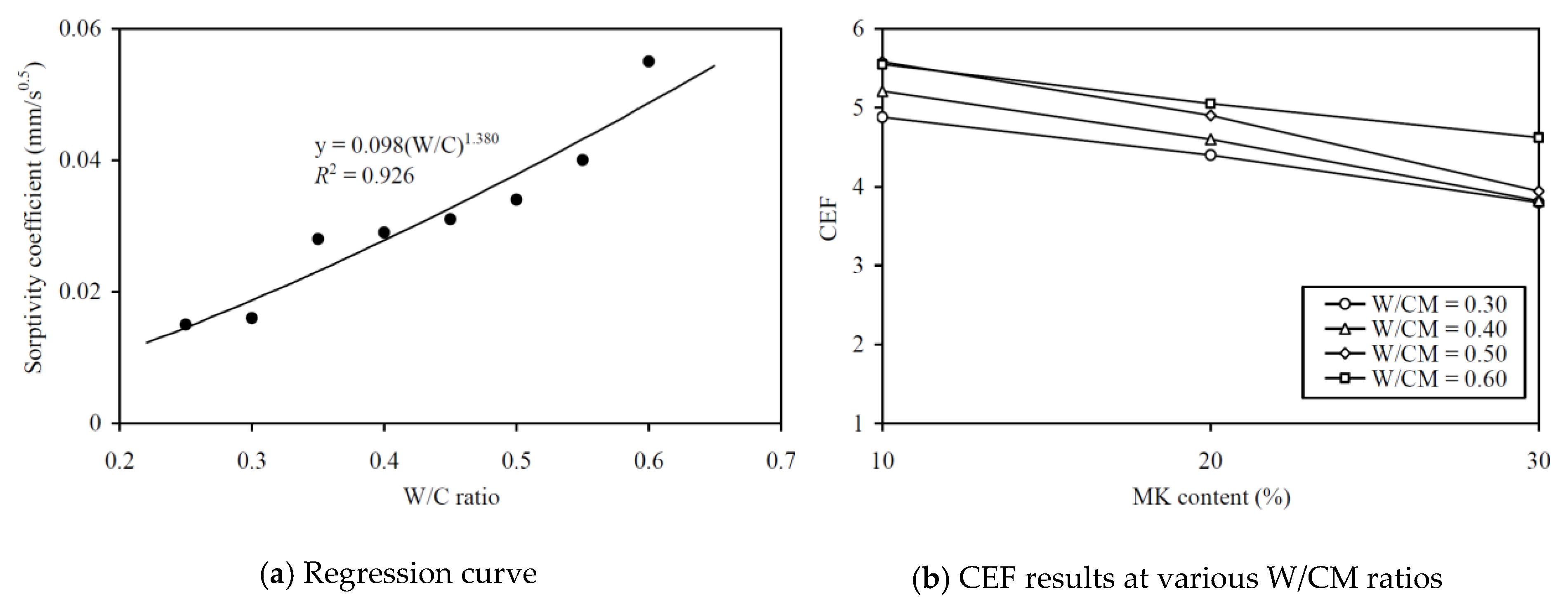
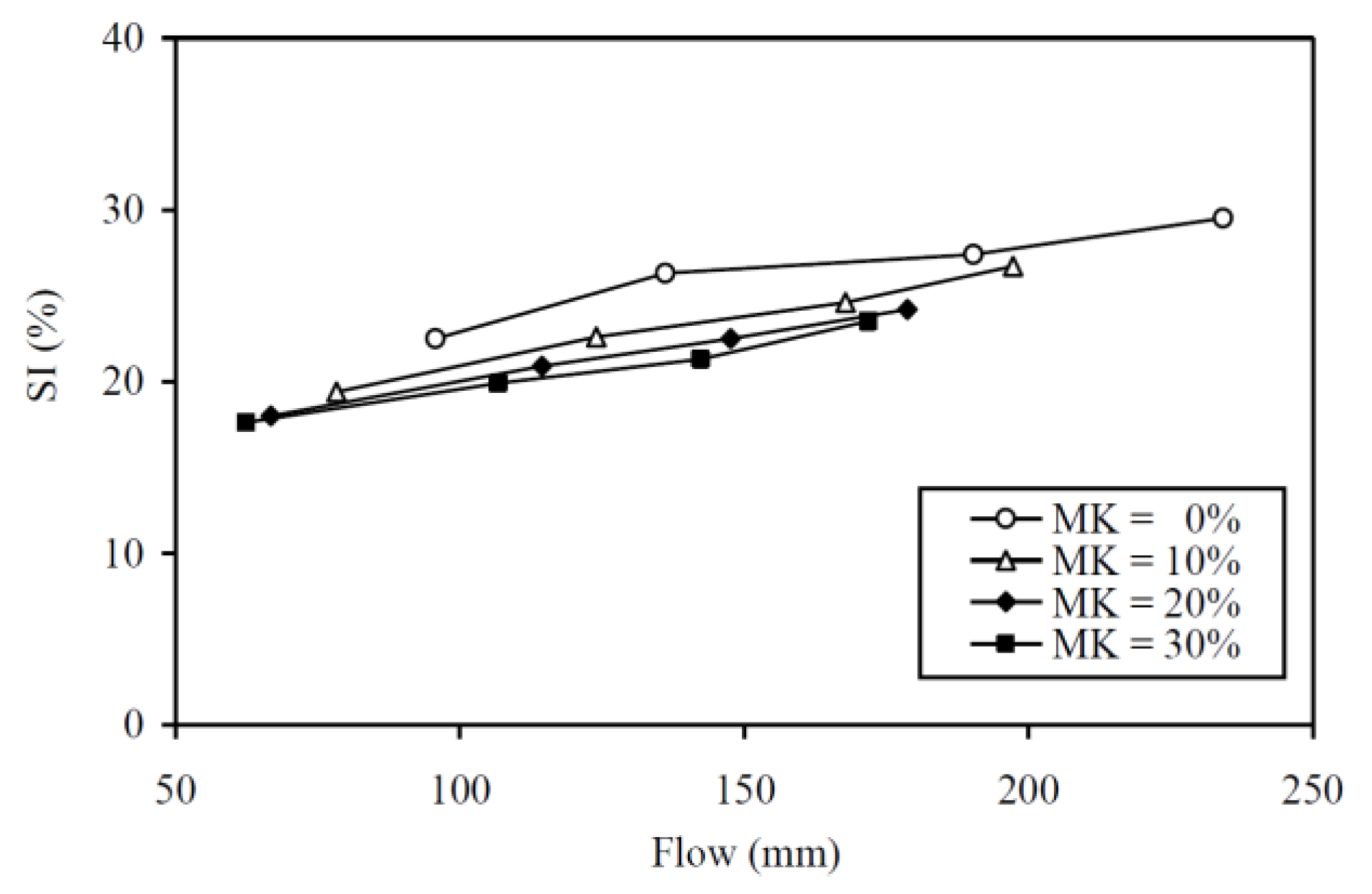
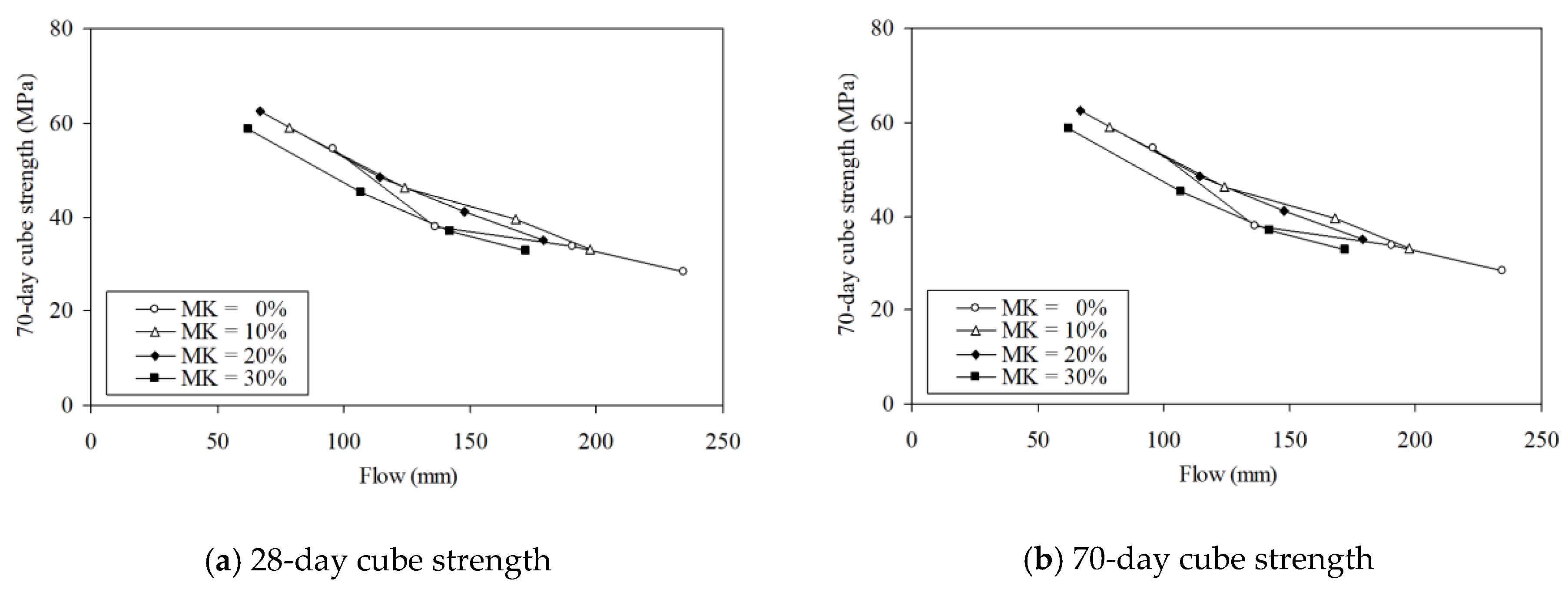
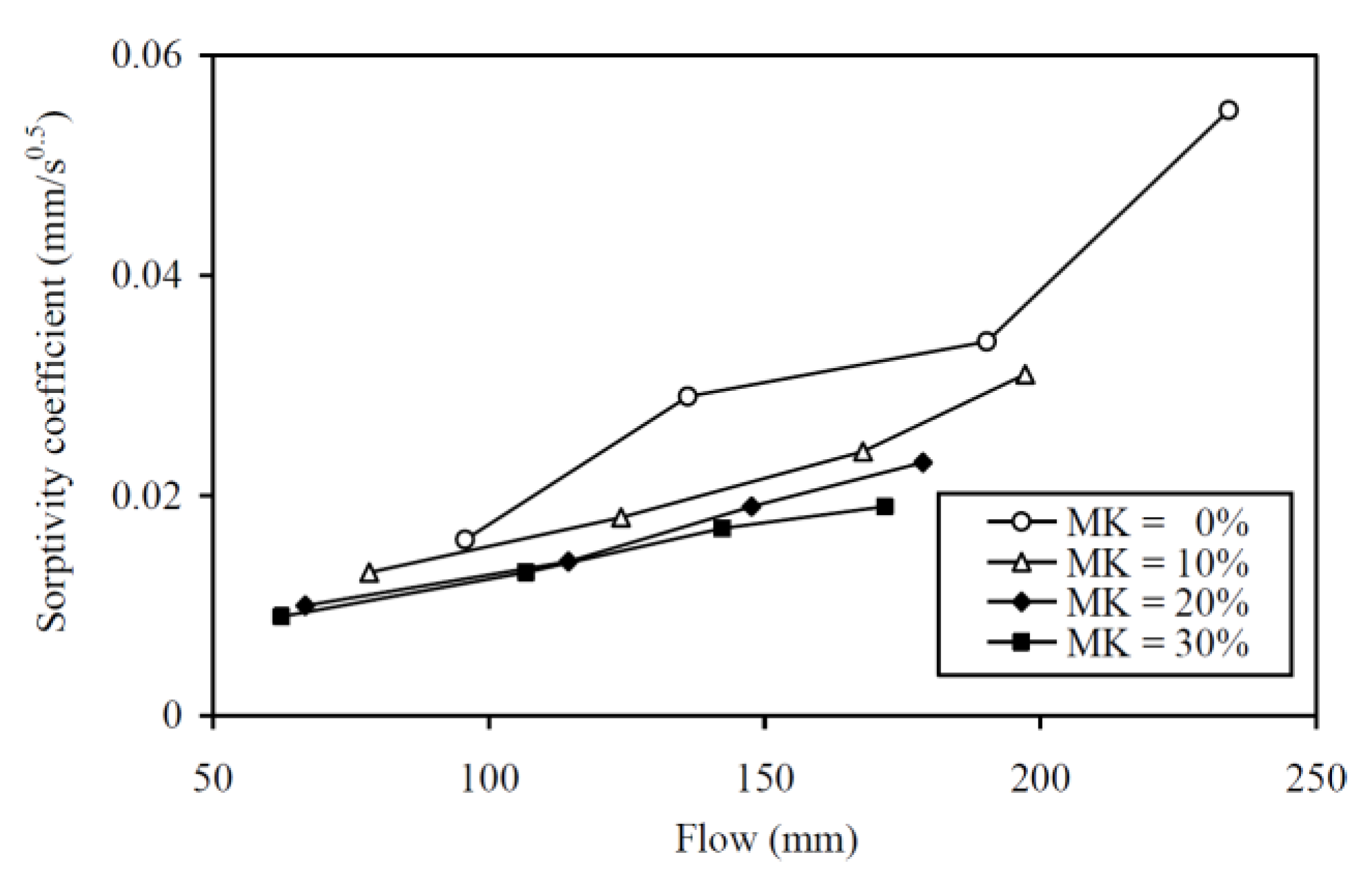
| Chemical Composition | OPC (%) | MK (%) |
|---|---|---|
| SiO2 | 23.9 | 51.7 |
| CaO | 62.3 | 0.5 |
| Al2O3 | 4.9 | 44.1 |
| Fe2O3 | 3.7 | 0.9 |
| MgO | 2.4 | < 0.3 |
| TiO2 | - | 1.4 |
| Na2O | < 0.3 | < 0.2 |
| K2O | 0.4 | < 0.1 |
| Loss on ignition | 1.9 | 0.6 |
| Mix No. (M-VMK- W/CM) | OPC (kg/m3) | MK (kg/m3) | Fine Aggregate (kg/m3) | Coarse Aggregate (kg/m3) | Water (kg/m3) | Super- Plasticiser (kg/m3) |
|---|---|---|---|---|---|---|
| M-0-0.25 | 663.7 | 0.0 | 634.0 | 951.0 | 146.0 | 19.9 |
| M-0-0.30 | 610.4 | 0.0 | 634.0 | 951.0 | 164.8 | 18.3 |
| M-10-0.30 | 553.7 | 51.4 | 634.0 | 951.0 | 163.4 | 18.2 |
| M-20-0.30 | 496.2 | 103.6 | 634.0 | 951.0 | 161.9 | 18.0 |
| M-30-0.30 | 437.7 | 156.7 | 634.0 | 951.0 | 160.5 | 17.8 |
| M-0-0.35 | 565.0 | 0.0 | 634.0 | 951.0 | 180.8 | 16.9 |
| M-0-0.40 | 525.9 | 0.0 | 634.0 | 951.0 | 194.6 | 15.8 |
| M-10-0.40 | 477.7 | 44.3 | 634.0 | 951.0 | 193.1 | 15.7 |
| M-20-0.40 | 428.5 | 89.5 | 634.0 | 951.0 | 191.7 | 15.5 |
| M-30-0.40 | 378.5 | 135.5 | 634.0 | 951.0 | 190.2 | 15.4 |
| M-0-0.45 | 491.9 | 0.0 | 634.0 | 951.0 | 206.6 | 14.8 |
| M-0-0.50 | 462.0 | 0.0 | 634.0 | 951.0 | 217.1 | 13.9 |
| M-10-0.50 | 420.0 | 39.0 | 634.0 | 951.0 | 215.7 | 13.8 |
| M-20-0.50 | 377.1 | 78.8 | 634.0 | 951.0 | 214.3 | 13.7 |
| M-30-0.50 | 333.4 | 119.4 | 634.0 | 951.0 | 212.8 | 13.6 |
| M-0-0.55 | 435.5 | 0.0 | 634.0 | 951.0 | 226.5 | 13.1 |
| M-0-0.60 | 411.9 | 0.0 | 634.0 | 951.0 | 234.8 | 12.4 |
| M-10-0.60 | 374.7 | 34.8 | 634.0 | 951.0 | 233.4 | 12.3 |
| M-20-0.60 | 336.7 | 70.3 | 634.0 | 951.0 | 232.0 | 12.2 |
| M-30-0.60 | 297.9 | 106.7 | 634.0 | 951.0 | 230.6 | 12.1 |
© 2020 by the authors. Licensee MDPI, Basel, Switzerland. This article is an open access article distributed under the terms and conditions of the Creative Commons Attribution (CC BY) license (http://creativecommons.org/licenses/by/4.0/).
Share and Cite
Chen, J.J.; Li, Q.H.; Ng, P.L.; Li, L.G.; Kwan, A.K.H. Cement Equivalence of Metakaolin for Workability, Cohesiveness, Strength and Sorptivity of Concrete. Materials 2020, 13, 1646. https://doi.org/10.3390/ma13071646
Chen JJ, Li QH, Ng PL, Li LG, Kwan AKH. Cement Equivalence of Metakaolin for Workability, Cohesiveness, Strength and Sorptivity of Concrete. Materials. 2020; 13(7):1646. https://doi.org/10.3390/ma13071646
Chicago/Turabian StyleChen, J.J., Q.H. Li, P.L. Ng, L.G. Li, and A.K.H. Kwan. 2020. "Cement Equivalence of Metakaolin for Workability, Cohesiveness, Strength and Sorptivity of Concrete" Materials 13, no. 7: 1646. https://doi.org/10.3390/ma13071646
APA StyleChen, J. J., Li, Q. H., Ng, P. L., Li, L. G., & Kwan, A. K. H. (2020). Cement Equivalence of Metakaolin for Workability, Cohesiveness, Strength and Sorptivity of Concrete. Materials, 13(7), 1646. https://doi.org/10.3390/ma13071646





